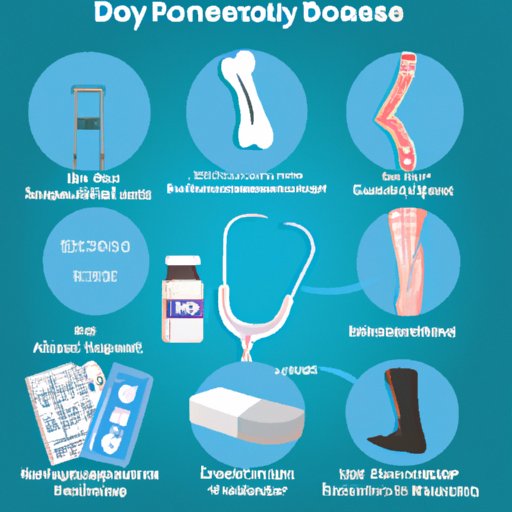
Introduction
Osteoporosis is a disease that weakens bones, making them fragile and more prone to fractures. It is a silent condition that can go unnoticed for many years until suddenly, a minor bump or fall can result in significant injury or broken bones. Osteoporosis is mainly prevalent in women, particularly after menopause, but men can also develop it as they age.
It is essential to seek treatment for osteoporosis to prevent bone loss and reduce the risk of fractures. Without proper treatment, a bone fracture can lead to a loss of mobility, chronic pain, and the need for long-term care. Therefore, it is crucial to understand the different treatment options available and work closely with your healthcare provider to determine the best approach for your specific needs.
Exploring the Various Medications for Osteoporosis Treatment: A Comprehensive Guide
There are several medications available for treating osteoporosis, including bisphosphonates, estrogen agonists/antagonists, calcitonin, and denosumab. Each medication works differently to prevent further bone loss, increase bone density, and reduce fracture risk.
Bisphosphonates are the most commonly prescribed medication for osteoporosis treatment. They work by slowing down bone resorption, which helps to maintain bone density and reduce fracture risk. Common bisphosphonates include alendronate, risedronate, ibandronate, and zoledronic acid.
Estrogen agonists/antagonists are a group of drugs that mimic or block the effects of estrogen in the body. They are effective in increasing bone density, reducing the risk of fractures, and treating menopause symptoms. The most commonly used estrogen agonist/antagonist is raloxifene.
Calcitonin is a hormone that helps regulate calcium levels in the body. It works by slowing down bone resorption and reducing the risk of fractures. Calcitonin is available as a nasal spray or injection.
Denosumab is a relatively new medication that works by blocking the development of osteoclasts, cells that break down and absorb bone tissue. By inhibiting bone resorption, denosumab can help to increase bone density and reduce the risk of fractures.
While each osteoporosis medication works differently, side effects are possible. These can include stomach upset, nausea, abdominal pain, and in rare cases, jaw problems. It is crucial to follow the recommended dosage and talk to your healthcare provider before taking any medication.
Preventing Bone Loss: Lifestyle Changes and Medications for Treating Osteoporosis
While medication is an essential component of osteoporosis treatment, lifestyle changes are also essential in preventing bone loss. Eating a healthy diet rich in calcium and vitamin D, quitting smoking, and regular exercise can help improve bone density and reduce the risk of fractures. Additionally, some medications may be used as part of a combined treatment approach for patients with severe osteoporosis.
Breaking Down Osteoporosis Treatment Options: Which One Is Right for You?
When choosing an osteoporosis treatment option, several factors should be taken into account, including age, medical history, and overall health. Your healthcare provider will help you identify the treatment approach that will be most effective for you. Additionally, with multiple treatment options available, it is essential to understand the different approaches to osteoporosis treatment, including medications, lifestyle changes, and natural remedies.
Holistic Approaches to Osteoporosis Treatment: Natural Remedies, Diet, and Exercise
While medication is an essential part of managing osteoporosis, natural remedies can be used to complement treatment and provide additional health benefits. For example, herbal remedies such as red clover and soy contain compounds that may help reduce bone loss and improve bone density. In addition, incorporating exercise such as weight-bearing exercises and strength training and a healthy diet can help prevent bone loss.
Managing Osteoporosis with Medications: Pros and Cons of Commonly Prescribed Drugs
While medications are effective in reducing bone loss and preventing fractures, they also have potential risks and side effects. Patients should be informed about the benefits and drawbacks of each medication to make the best-informed decision. For example, bisphosphonates may increase the risk of fractures in the femur, a long bone in the leg, after long-term use. However, the benefits of reducing the risk of spinal fractures still outweigh this potential risk for many patients. Therefore, it is crucial to discuss potential risks and benefits with your healthcare provider before starting any medication.
New Advances in Osteoporosis Treatment: Emerging Therapies and Research Breakthroughs
New therapies are continuously being developed and evaluated for osteoporosis treatment. For example, romosozumab, a new medication, works by inhibiting the protein sclerostin, which can help to build new bone. This new drug is currently being studied and offers new hope for patients with severe osteoporosis that has not responded to other treatments. Other studies are investigating drug combinations, innovative drug delivery systems, and genetic therapies. These clinical trials offer hope for new treatment options that may improve outcomes for patients with osteoporosis.
Conclusion
Osteoporosis is a prevalent disease that can cause significant health consequences if left untreated. Fortunately, several treatment approaches are available, including medications, lifestyle changes, natural remedies, and emerging therapies. By working with a healthcare provider, patients can identify the treatment approach that will be most effective for them and reduce their risk of bone fractures.




